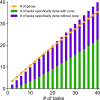Evolution of weak cooperative interactions for biological specificity
- PMID: 30404915
- PMCID: PMC6255166
- DOI: 10.1073/pnas.1815912115
Evolution of weak cooperative interactions for biological specificity
Abstract
A hallmark of biological systems is that particular functions and outcomes are realized in specific contexts, such as when particular signals are received. One mechanism for mediating specificity is described by Fisher's "lock and key" metaphor, exemplified by enzymes that bind selectively to a particular substrate via specific finely tuned interactions. Another mechanism, more prevalent in multicellular organisms, relies on multivalent weak cooperative interactions. Its importance has recently been illustrated by the recognition that liquid-liquid phase transitions underlie the formation of membraneless condensates that perform specific cellular functions. Based on computer simulations of an evolutionary model, we report that the latter mechanism likely became evolutionarily prominent when a large number of tasks had to be performed specifically for organisms to function properly. We find that the emergence of weak cooperative interactions for mediating specificity results in organisms that can evolve to accomplish new tasks with fewer, and likely less lethal, mutations. We argue that this makes the system more capable of undergoing evolutionary changes robustly, and thus this mechanism has been repeatedly positively selected in increasingly complex organisms. Specificity mediated by weak cooperative interactions results in some useful cross-reactivity for related tasks, but at the same time increases susceptibility to misregulation that might lead to pathologies.
Keywords: evolvability; gene regulation; phase separation; specificity; weak cooperative interactions.
Copyright © 2018 the Author(s). Published by PNAS.
Conflict of interest statement
The authors declare no conflict of interest.
Figures




References
-
- Kirschner M, Gerhart JC, Norton J. The Plausibility of Life: Resolving Darwin’s Dilemma. Yale Univ Press; New Haven, CT: 2006.
Publication types
MeSH terms
Substances
Grants and funding
LinkOut - more resources
Full Text Sources

